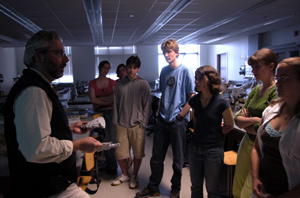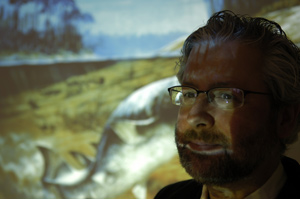|
||
      |
Coursework: Fossil-fueled
Neil Shubin shares his adventures from the tetrapod front.

In early April, Neil Shubin’s fish story set off a media frenzy that most paleontologists can only dream of. “Fossil called missing link from sea to land animals,” read the headline in the New York Times. The Times of London went further, declaring Tiktaalik roseae the “fish that took the first step for mankind.” Shubin, a professor of organismal biology and anatomy, was even named “Person of the Week” by ABC World News Tonight.
A month later, Shubin is getting ready to tell the nine first-years in his Chordate Evolutionary Biology course how he came to make such an astonishing discovery. Shubin team-teaches the course with Michael Coates, another organismal biology and anatomy professor; Coates already covered Tiktaalik during a lecture a few weeks earlier. Today’s slide show is not so much the science version as the adventure version. In his white button-down shirt and black vest, Shubin projects more than a hint of Indiana Jones.
The lab, Biological Sciences Learning Center 438, is circa 2000. But other than Shubin’s silver laptop, most of the equipment would be right at home in a Victorian anatomy lab. The walls are lined with specimens: bullfrog and turtle skeletons, a shark floating in a jar, and other pickled creatures, most unlabeled. Behind Shubin hangs a human skeleton. Its right hand rests insouciantly on its hip; its head and right leg are missing.
In 1992, Shubin tells the class, he was a new professor at the University of Pennsylvania. “I had done a lot of fieldwork as a graduate student, and I was trying to think of a field project that I could do relatively cheaply out of Philadelphia.” Along with graduate student Ted Daeschler, he decided to work on the Devonian Age rocks—about 370 to 362 million years old—in Pennsylvania. In these rocks, already well-known to geologists and paleontologists, they hoped to find fossil bones that would show the evolutionary transition from fish to tetrapods (vertebrates with four feet).
“The holy grail for us,” says Shubin, “was, and still is, to understand the elpistostegid-to-tetrapod part of the tree.” While Coates—who published “a phenomenal monograph on early tetrapods” around the same time—approached the fish-tetrapod transition from the amphibian side, Shubin explains, “we wanted to approach it from the fish side.”
He flips to a slide of a steep hill with a road slicing through it. “To find a fossil site,” he says, “you look for three things”: rocks from the same era as the creature you’re in search of, rocks whose composition has preserved the carcass, and rocks exposed to the surface. Pennsylvania’s Devonian rocks were “perfect, except in one key way,” he says. “You’re limited to where the Pennsylvania Department of Transportation decides to build a road.”
During their weekend trips, he and Daeschler found a lot of early tetrapod fossils, but mainly just “bits and pieces, a shoulder, humeri, isolated bones,” Shubin says. “And furthermore, who wants to work on road cuts? Why can’t I do something really adventurous, in the desert like [Chicago professor and dinosaur tracker] Paul Sereno?” The class laughs. “Instead I have truckers honking at me all day. It was not the most elegant of experiences.”
Then in 1998, he and Daeschler were in his office at Penn, in the midst of some now-forgotten dispute. “To settle the argument, I went to an undergraduate geology textbook which happened to be on the shelf,” Shubin says. “Ted and I are going at it, I’m going through the book, and we run across this illustration.”
The next slide shows a geological map of North America, with nonmarine Devonian rocks marked in red. For the first time, they noticed a red blotch “going right across the Canadian Arctic,” Shubin says. “It seemed to be a phenomenal opportunity”: the right age and type of rocks, and best of all “no shopping malls or miniature-golf courses on top.”
In the summer of 1999 Shubin and Daeschler made their first expedition. They started in the western part of the Arctic, in the ancient seas. In subsequent years they worked further and further east. But again, they did not find what they were seeking—or so they thought. After the 2002 expedition, among the fossils that ended up in Daeschler’s possession was a specimen that Shubin, by then based in Chicago, had not seen. It was a jaw marked “lungfish.”
“The following year, Matt Friedman was visiting Philadelphia.” Shubin nods at Friedman, a blond, bearded young man leaning against the wall; then a grad student at Cambridge, he’s now one of Shubin’s teaching assistants. “I don’t know the exact story,” Shubin says, “but Matt said, ‘I think this is an elpistostegid’.”
(“I don’t want to make it sound as if I’m the only person who would recognize it,” Friedman says later. “Had Neil seen it, he would have flagged it.”)
Based on that realization, Shubin and Daeschler (now at the Academy of Natural Sciences in Philadelphia) decided to return to the Canadian Arctic in 2004. “Our funders said, ‘This is your last trip. We are pulling the plug,’” Shubin says. “It’s really expensive to work there” because it’s so remote. The team and all its supplies must be flown in by helicopter or Twin Otter planes, rugged “bush” aircraft that can land and take off in extremely tight spots. Weight is also a concern: “We’re packing now for July. If you go to my lab, it smells like fruit salad, because the dehydrator is making fruit roll-ups. Last week it smelled like beef jerky.”
Just as the weight the researchers carry in is limited, so is the weight they can bring out. “We found lots of Tiktaaliks up there, but we were only able to take a few skeletons home, because they’re so heavy.”
Shubin flips to a photograph of the rock where the famous fossil—a new type of elpistostegid—was found. He holds a plaster cast over the slide to show its original orientation in the rock. “Finding these things is simple. Getting them home is hard,” he says. “It’s a race against time. We’re only there for a month, the weather’s pretty grim, and the plaster”—which encases the fossil to protect it—“doesn’t like to dry. We have to sleep with the things so they get warm enough.”

Shubin sets down the cast. “Would this animal have been able to walk? Probably not,” he says, imitating how it might have propped itself up, like a baby learning to crawl. “If you want to see the original bones, they’re in my office, so drop by.”
His next expedition is planned for this July, says Shubin, father of four-year-old Nathan and one-year-old Hannah. “We go back every two years. It’s hard to go back every year, if you have young kids like I have.”
Slide show over, the room’s blinding fluorescent lights switch on. Now Coates takes over the class, first warning the students about a paper due in a few weeks. Then comes “the painful bit,” he says—returning the midterms. “Right,” he says afterward, “carry on, chaps.”
The chaps laugh, find their lab partners, and pull on High Five latex-free gloves to begin today’s dissection. The stench of preserved death fills the room; the windows do not open. It’s not formaldehyde but Carosafe, a newer preservative composed mainly of propylene glycol. “It only causes cancer in 50 percent of people exposed to it,” John Finarelli, SM’04, the other TA, quips.
“Gentlemen naturalists oftentimes pickled their specimens in rum,” Friedman observes. “It actually preserves the DNA better than formaldehyde.”
Each pair of students slides a strange, skinned creature out of a plastic bag: a cat. So much for paleontologists’ adventure stories; now it’s back to basics.
Syllabus
Chordate Evolutionary Biology meets on Tuesdays and Thursdays; the lectures, from 1:30 to 2:30 p.m., are followed by a dissection lab from 3 to 6. The course is team-taught by Michael Coates and Neil Shubin, along with two teaching assistants. This spring nine students enrolled in the class, for a student-teacher ratio of just over 2:1.
Coates gives the lectures for the first half of the course, beginning with the simplest vertebrates and ending with dinosaurs, birds, and mammals. Then Shubin covers the same subject matter from the perspective of systems rather than creatures, starting at embryology, the skull, and locomotion and finishing with excretion and reproduction. Texts include Vertebrates: Comparative Anatomy, Function, Evolution by Kenneth Kardong and Vertebrate Dissection by Dominique Homberger and Warren Walker. The lecture material is tested by a midterm (15 percent) and a final (25 percent), the lab work by a lab exam (30 percent) and a dissection notebook (15 percent). Students must also write one paper (15 percent).
For the first-years, the class’s most intimidating aspect was not slicing into pickled cats (or even the human cadavers planned for later in the quarter) but researching the paper—where they were required to use books rather than online sources. In an informal verbal poll by teaching assistant John Finarelli, only one student had been to the science quadrangle’s John Crerar Library—”just once,” she said, qualifying her unusual accomplishment, “during O-week.”